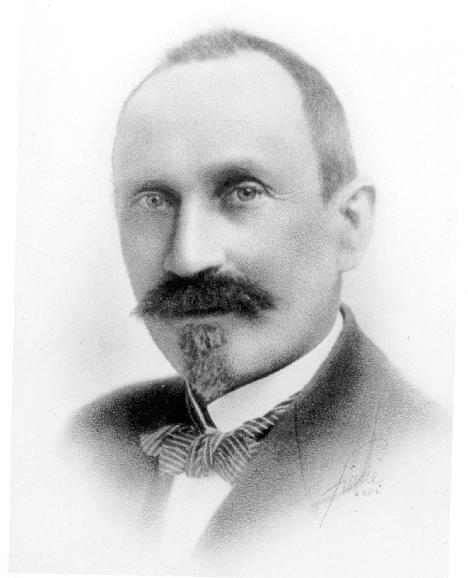<Back to Index>
- Researcher and Inventor Jens William Aegidius Elling, 1861
- Mechanic Ernest Godward, 1869
- Inventor René Lorin, 1877
PAGE SPONSOR

Jens William Ægidius Elling (also Aegidus or Aegidius) (July 26, 1861 – 1949) was a Norwegian researcher, inventor and pioneer of gas turbine who is considered to be the father of the gas turbine. He built the first gas turbine that was able to produce more power than needed to run its own components.
Elling was born in and grew up in Oslo, Norway. He studied mechanical engineering at Kristiania Technical College, (now part of the University of Oslo) graduating in 1881. Between 1885 - 1902, he worked as an engineer and designer at a number of workshops in Sweden and Norway.
His first gas turbine patent was granted in 1884. In 1903 he completed the first turbine that produced excess power; his original machine used both rotary compressors and turbines to produce 11 bhp (8 kW; 11 PS) net. He further developed the concept, and by 1912 he had developed a gas turbine system with separate turbine unit and compressor in series, a combination that is now common.
One major challenge was to find materials that could withstand the high temperatures developed in the turbine to achieve high output powers. His 1903 turbine could withstand inlet temperatures up to 400° Celsius. Elling understood that if better materials could be found, the gas turbine would be an ideal power source for airplanes. Many years later, Sir Frank Whittle, building on the early work of Elling, managed to build a practical gas turbine engine for an airplane, the jet engine. Elling's gas turbine prototypes from 1903 and 1912 are exhibited at Norsk Teknisk Museum in Oslo.
Elling also did significant development work in other areas, such as steam engine controls, pumps, compressors, vacuum drying et cetera.
In 1914 Elling produced a book called Billig opvarmning: veiledning i at behandle magasinovner økonomisk og letvint. (English: Cheap Heating: Guidance for the simple and economical treatment of base burners), which was published by Aschehoug. Books written by Elling are now rare, and are mostly found in museums and libraries.

Ernest Godward was born in Marylebone, London, on April 7, 1869. His working life began as an apprentice in London for a firm of hydraulic engineers and fire engine manufacturers. Here he trained as a mechanic.
In 1886 he arrived at Port Chalmers, New Zealand, aboard the Nelson. He settled in Dunedin for a time before shifting to Invercargill in 1893. He became a partner in the Southland Cycle Works.
In 1896 he married Marguerita Florence Celena Treweek and the couple had 10 children. The Southland Cycle Works was not stimulating enough for Godward's energetic mind so he began inventing by looking at everyday objects and thinking of ways to improve them.
By 1900 he had invented and patented an egg beater that could prepare eggs for a sponge cake in three and a half minutes, previously it took 15. He also invented a new post hole borer, a new type of hair curler, a burglar proof window and a hedge trimmer made from bicycle parts.
Major success came in 1901 with the invention of the spiral hairpin. This was a predecessor of the hair clip. He left the bicycle business and established various invention and trading companies. The American rights to the spiral hairpin were sold for 20,000 pounds, a fortune in 1901.
From 1903 - 1906 Godward served on the Invercargill Borough Council, built an impressive new house, painted portraits and landscapes, played a variety of musical instruments and sang in local musical productions.
In 1908 he started a motorcycle business in Invercargill and fitted the imported bikes with his own invention – a petrol economizer. His economizers worked as well in cars as they did in motorcycles. He invented 72 models of the economizer and by the 1930s was recognized as the world’s leading authority on the internal combustion engine.
For much of this time he was based in New York. Marguerita continued to live in Invercargill.
In 1929 the city of Philadelphia, one of the largest public transport operators in the United States, adopted the invention. Some 580 buses and 3000 taxis were fitted with the vaporizer.
Godward died in 1936 on board the SS Mongolia returning home to Invercargill.
René Lorin (1877 – 1933), a graduate of the Ecole Centrale Paris, invented the ramjet. In 1908 he patented a subsonic ramjet design.
Lorin published the principles of a ramjet in articles in the journal L'Aérophile from 1908 to 1913, expressing the idea that the exhaust from internal combustion engines could be directed into nozzles to create jet propulsion. He could not build this invention since there was no way at the time for an aircraft to go fast enough for a ramjet to function properly.
When René Leduc applied for a patent on a ramjet design in 1933, he discovered Lorin's publications and tried to contact him, only to learn that he had recently died. Leduc thereafter paid homage to Lorin's work.